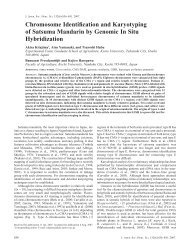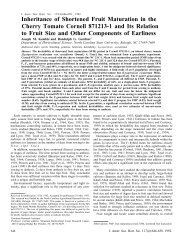Consumer Tastes, Preferences, and Behavior in Purchasing Fresh ...
Consumer Tastes, Preferences, and Behavior in Purchasing Fresh ...
Consumer Tastes, Preferences, and Behavior in Purchasing Fresh ...
You also want an ePaper? Increase the reach of your titles
YUMPU automatically turns print PDFs into web optimized ePapers that Google loves.
from California <strong>and</strong> other distant locations dur<strong>in</strong>g the short, local<br />
market<strong>in</strong>g season (July through September). Tomatoes from compet<strong>in</strong>g<br />
sources often have been picked mature-green <strong>and</strong> treated<br />
with ethylene gas to ripen them. If the fruit is picked when it is<br />
immature or is h<strong>and</strong>led improperly, ethylene-ripened tomatoes can<br />
have a dry, mealy <strong>in</strong>terior, <strong>and</strong> <strong>in</strong>ferior flavor. Greenhouse <strong>and</strong><br />
ethylene-gassed tomatoes are both more uniform <strong>in</strong> size <strong>and</strong> <strong>in</strong><br />
color than New Jersey tomatoes, which gives them eye appeal over<br />
New Jersey tomatoes.<br />
The “Jersey <strong>Fresh</strong>” st<strong>and</strong>ard tomato was <strong>in</strong>troduced by the New<br />
Jersey Dept. of Agr. <strong>in</strong> the early 1980s as part of its “Jersey <strong>Fresh</strong>”<br />
campaign to promote local produce <strong>and</strong> to reverse the shift <strong>in</strong><br />
vegetable production from New Jersey to other areas. In 1988, the<br />
“Jersey <strong>Fresh</strong> Premium” tomato was <strong>in</strong>troduced. This tomato was<br />
graded <strong>and</strong> packaged to be a superior <strong>and</strong> differentiated product of<br />
even higher quality than the Jersey <strong>Fresh</strong> st<strong>and</strong>ard. The expectation<br />
was that these products labeled as high quality would comm<strong>and</strong><br />
higher prices. In reality, whether or not consumers realize<br />
such expectation depends on how they perceive the differentiation<br />
<strong>and</strong> superiority of these two products.<br />
A differentiated product is one that is truly unique <strong>in</strong> the m<strong>in</strong>d<br />
of the consumer. A differentiated product of higher quality should<br />
comm<strong>and</strong> a higher price (Jordan et al., 1985) <strong>and</strong> should have<br />
fewer substitutes than compet<strong>in</strong>g products (Tomek <strong>and</strong> Rob<strong>in</strong>son,<br />
1972). Such products are also expected to have a lower own-price<br />
elasticity of dem<strong>and</strong> than compet<strong>in</strong>g products; this means that<br />
quantity dem<strong>and</strong>ed for a superior quality-differentiated product<br />
changes by a smaller percentage than does the quantity dem<strong>and</strong>ed<br />
of a low quality product when the prices of both products change<br />
by the same percentage (consumers are less sensitive to the price<br />
of better quality products). Better quality, differentiated products<br />
should also have greater <strong>in</strong>come elasticity than lower quality<br />
products; this means that when consumers’ <strong>in</strong>comes <strong>in</strong>crease<br />
(everyth<strong>in</strong>g else held constant), they <strong>in</strong>crease their consumption of<br />
a better quality, differentiated product by a larger percentage than<br />
that of a lower quality product. If consumers perceive Jersey <strong>Fresh</strong><br />
tomatoes to be a superior, differentiated product, that perception<br />
should be reflected <strong>in</strong> their purchas<strong>in</strong>g patterns <strong>and</strong> <strong>in</strong> the estimated<br />
elasticities of dem<strong>and</strong> for various types of tomatoes.<br />
A dem<strong>and</strong> regression analysis conducted <strong>in</strong> this study helps to<br />
determ<strong>in</strong>e the factors that significantly affect the dem<strong>and</strong> for Jersey <strong>Fresh</strong><br />
tomatoes <strong>and</strong> compet<strong>in</strong>g tomatoes <strong>and</strong> helps to identify the uniqueness<br />
<strong>and</strong> quality of Jersey <strong>Fresh</strong> tomatoes. The regression analysis considered<br />
consumer perceptions of tomatoes <strong>and</strong> actual purchase behavior.<br />
Materials <strong>and</strong> Methods<br />
Jersey <strong>Fresh</strong> st<strong>and</strong>ard, Jersey <strong>Fresh</strong> Premium, <strong>and</strong> other types<br />
of tomatoes were offered for sale at various prices <strong>in</strong> four stores <strong>in</strong><br />
the K<strong>in</strong>gs Super Markets cha<strong>in</strong> <strong>in</strong> northern New Jersey <strong>in</strong> July <strong>and</strong><br />
Sept. 1988. The K<strong>in</strong>gs Super Markets cha<strong>in</strong> targets high <strong>in</strong>come<br />
consumers <strong>and</strong> was thus identified as a potential market niche for<br />
premium tomatoes.<br />
A total of 757 face-to-face <strong>in</strong>terviews with both purchasers <strong>and</strong><br />
nonpurchasers were conducted <strong>in</strong> the produce section of four<br />
selected K<strong>in</strong>gs stores after respondents had selected tomatoes but<br />
before they had paid for them. Prices on dates of the survey were<br />
collected (Table 1) <strong>and</strong> the distribution of purchases on the day of the<br />
survey monitored (Table 2). Surveyors recorded quantities, prices,<br />
<strong>and</strong> types of tomatoes respondents bought. Respondents were<br />
asked three sets of questions to determ<strong>in</strong>e their tastes <strong>and</strong> preferences<br />
for Jersey <strong>Fresh</strong> tomatoes <strong>and</strong> other fresh tomatoes. Respondents<br />
were asked if lack of blemishes, firmness, ripeness, color,<br />
time of year, orig<strong>in</strong>, price, size, uniformity, household size, <strong>and</strong><br />
package size were “important” to their purchase decisions. Their<br />
responses were converted <strong>in</strong>to <strong>in</strong>teger variables (1 if unimportant,<br />
2 if important, <strong>and</strong> 3 if very important). Respondents were also<br />
asked how Jersey <strong>Fresh</strong> tomatoes compare with other tomatoes <strong>in</strong><br />
terms of freshness, flavor, appearance, price, storage life, nutrition,<br />
<strong>and</strong> overall. These “rank<strong>in</strong>g” variables were expressed as<br />
b<strong>in</strong>ary variables (1 if Jersey <strong>Fresh</strong> was better, 0 if Jersey <strong>Fresh</strong> was<br />
not better). <strong>Consumer</strong>s were further asked if they had been disappo<strong>in</strong>ted<br />
with past purchases of fresh tomatoes because of flavor,<br />
not ripe, overripe, firmness, freshness, color, damaged/bruised,<br />
blemishes, or size. The “disappo<strong>in</strong>tment” variables were also<br />
expressed as b<strong>in</strong>ary variables (1 if an item was a reason for<br />
disappo<strong>in</strong>tment, 0 if it was not). The important rank<strong>in</strong>g <strong>and</strong><br />
disappo<strong>in</strong>tment variables constitute taste <strong>and</strong> preference variables.<br />
Demographic variables (education, <strong>in</strong>come, age, family size,<br />
gender, <strong>and</strong> race) were tested for <strong>in</strong>dependence. Education <strong>and</strong><br />
<strong>in</strong>come were positively correlated with each other, whereas age<br />
<strong>and</strong> <strong>in</strong>come were negatively correlated with each other. Based on<br />
correlation coefficients <strong>and</strong> the parameter estimates of an equation<br />
that described household <strong>in</strong>come as a function of education, age,<br />
<strong>and</strong> family size, age <strong>and</strong> education were dropped from equation (1)<br />
to reduce multicoll<strong>in</strong>earity (Maddala, 1977). A dummy variable<br />
for gender was <strong>in</strong>cluded as an exogenous variable <strong>and</strong> was found<br />
to be strongly nonsignificant; therefore, gender was elim<strong>in</strong>ated<br />
from the dem<strong>and</strong> equation. Quantity purchased was expressed on<br />
434 J. Amer. Soc. Hort. Sci. 118(3):433-438. 1993.
















